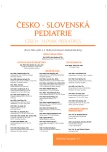Long-term consequences of preterm birth on respiratory system in children
Authors:
J. Tuková; P. Koťátko
Authors‘ workplace:
Klinika pediatrie a dědičných poruch metabolismu 1. LF UK a VFN, Praha
Published in:
Čes-slov Pediat 2020; 75 (7): 393-400.
Category:
Overview
Preterm birth is associated with increased respiratory morbidity and mortality. The severity of long-term structural and functional changes is usually inversely related to gestational age and birth weight category. Chronic lung disease of immaturity is mainly developed in very preterm (28–31 week of gestation) and extremely preterm infants (bellow 28 week of gestation) and its development is not necessarily associated with the diagnosis of bronchopulmonary dysplasia.
Despite the impact of immaturity on the vulnerable developing respiratory tract is moderated by huge progress in the development of modern medical equipment for respiratory support and pharmacotherapy; however, these advances lead to the general total increment of infants with the immature respiratory tract. The whole number of children with severe CLDI remain stable. Immaturity, together with other additional compounding factors, may lead to persistent respiratory tract pathology with improving clinical manifestation during childhood but lifelong functional and structural abnormality with uncertain prognosis till adulthood.
Keywords:
prematurity – bronchopulmonary dysplasia – chronic lung disease of immaturity – Lung development – pulmonary function test
Sources
1. Harrison MS, Goldenberg RL. Global burden of prematurity. Semin Fetal Neonatal Med 2016; 21 (2): 74–79.
2. Costeloe KL, et al. Short term outcomes after extreme preterm birth in England: comparison of two birth cohorts in 1995 and 2006 (the EPICure studies). BMJ 2012; 345: e7976.
3. Stoll BJ, et al. Trends in care practices, morbidity, and mortality of extremely preterm neonates, 1993–2012. JAMA 2015; 314 (10): 1039–1051.
4. Younge N, et al. Survival and neurodevelopmental outcomes among periviable infants. N Engl J Med 2017; 376 (7): 617–628.
5. Bolton CE, et al. Lung consequences in adults born prematurely. Thorax 2015; 70 (6): 574–580.
6. Day CL, Ryan RM. Bronchopulmonary dysplasia: new becomes old again! Pediatr Res 2017; 81 (1–2): 210–213.
7. Northway WH Jr, Rosan RC, Porter DY. Pulmonary disease following respirator therapy of hyaline-membrane disease. Bronchopulmonary dysplasia. N Engl J Med 1967; 276 (7): 357–368.
8. Jobe AJ. The new BPD: an arrest of lung development. Pediatr Res 1999; 46 (6): 641–643.
9. Higgins RD, et al. Bronchopulmonary Dysplasia: Executive Summary of a Workshop. J Pediatr 2018; 197 : 300–308.
10. Jobe AH, Bancalari E. Bronchopulmonary dysplasia. Am J Respir Crit Care Med 2001; 163 (7): 1723–1729.
11. Stoecklin B, Simpson SJ, Pillow JJ. Bronchopulmonary dysplasia: Rationale for a pathophysiological rather than treatment based approach to diagnosis. Paediatr Respir Rev 2019; 32 : 91–97.
12. Kalikkot Thekkeveedu R, Guaman MC, Shivanna B. Bronchopulmonary dysplasia: A review of pathogenesis and pathophysiology. Respir Med 2017; 132 : 170–177.
13. Ehrenkranz RA, et al. Validation of the National Institutes of Health consensus definition of bronchopulmonary dysplasia. Pediatrics 2005; 116 (6): 1353–1360.
14. Fawke J, et al. Lung function and respiratory symptoms at 11 years in children born extremely preterm: the EPICure study. Am J Respir Crit Care Med 2010; 182 (2): 237–245.
15. Caskey S, et al. Structural and functional lung impairment in adult survivors of bronchopulmonary dysplasia. Ann Am Thorac Soc 2016; 13 (8): 1262–1270.
16. Straňák Z. Imunoprofylaxe závažných forem RSV infekce neovlivňuje očkování u dětí - nová indikační kritéria. Pediatr praxi 2015; 16 (4): 247–250.
17. Duijts L, et al. European Respiratory Society guideline on long-term management of children with bronchopulmonary dysplasia. Eur Respir J 2020; 55 (1).
18. Baraldi E, et al. Low exhaled nitric oxide in school-age children with bronchopulmonary dysplasia and airflow limitation. Am J Respir Crit Care Med 2005; 171 (1): 68–72.
19. Gough A, et al. Impaired lung function and health status in adult survivors of bronchopulmonary dysplasia. Eur Respir J 2014; 43 (3): 808–816.
20. Quanjer PH, et al. Multi-ethnic reference values for spirometry for the 3-95-yr age range: the global lung function 2012 equations. Eur Respir J 2012; 40 (6): 1324–1343.
21. Stocks J, Hislop A, Sonnappa S. Early lung development: lifelong effect on respiratory health and disease. Lancet Respir Med 2013; 1 (9): 728–742.
22. Urs R, et al. Persistent and progressive long-term lung disease in survivors of preterm birth. Paediatr Respir Rev 2018; 28 : 87–94.
23. Narayanan M, et al. Catch-up alveolarization in ex-preterm children: evidence from (3)He magnetic resonance. Am J Respir Crit Care Med 2013; 187 (10): 1104–1109.
Labels
Neonatology Paediatrics General practitioner for children and adolescentsArticle was published in
Czech-Slovak Pediatrics

2020 Issue 7
Most read in this issue
- When should a physician consider ciliary dysfunction?
- How and when to perform pulmonary function testing in infants
- Long-term consequences of preterm birth on respiratory system in children
- Paediatric pulmonology in the Czech Republic and Slovakia
